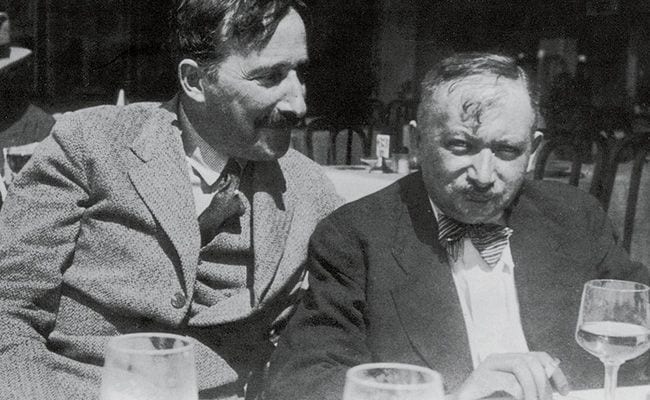
In the summer of 1936, a cast of Europe’s literary elite and political rebels gather at the Belgian seaside resort town of Ostend: to write, to love, to argue, and to contemplate their next move in a world grown dark and deadly. Dangerous characters? If you count idealists, cynics, writers, Communists, and Jews dangerous. Which, of course, the spreading fist of fascism does.
Europe is about to disintegrate into war, but already, this motley (yet stylish) cast has felt the chill. Jewish writers like Joseph Roth have had their books banned in Germany and other fascist strongholds; Jewish writers like Stefan Zweig, who try to stay out of politics, face ostracism for still being published in these same countries.
Zweig, however, is a millionaire, unlike his impoverished friend Roth. Zweig has just left his wife and daughters for his secretary, Lotte Altmann; upon joining him, the sickly Roth and the dashing, beautiful German novelist Irmgard Keun quickly hit it off. Fascism, exile, war, and love – the ingredients for a master novel are all here; only this is real life, not art. Sometimes, the distinction is hard to draw.
Volker Weidermann, a journalist, editor, and literary historian, takes full advantage of this blurred boundary to offer an extended literary essay that reads with all the power and passion of a novel itself. He paints a stirring portrait of these characters and their gathering together at this particular moment in time. His stylized yet impressively researched work Ostend: Stefan Zweig, Joseph Roth, and the Summer Before the Dark is a beautiful example of literary journalism and storytelling.
The short yet powerful book (brilliantly translated by Carol Brown Janeway, who tragically died shortly after completing it) chronicles these larger-than-life figures, wrapping its action around that fateful and beautiful summer of 1936 in Ostend, but crafting a larger sense of time and place all round it. The dynamics of a complicated literary friendship between Stefan Zweig and Joseph Roth intersects with those of literary romance (Joseph Roth and Irmgard Keun).
Around them are woven an equally dramatic and powerful cast of secondary characters: the journalist and writer Arthur Koestler; the Communist organizer Willi Muenzenberg; the wealthy and famous journalist Egon Erwin Kisch; playwright Ernst Toller; poet Emile Verhaeren; actress Christiane Grautoff; the struggling novelist Hermann Kesten who would outlive them all; and several more. They argue politics; they write beautiful literature; they love with all the pain and passion that feeling is capable of producing. Although the summer of 1936 is the focus of the novel, Weidermann backtracks and fast-forwards as necessary to help us understand the characters, the powerful forces and histories that have led them to this moment, and finally, the fate that pursues each of them after they part ways.
This is a history that reads like the best narrative fiction. The reader does not care that the action transpired eight decades ago; the passion and struggle depicted here feels like yesterday.
Weidermann evokes a remarkable sense of spirit and place: re-animating dark evenings of furious writing in bistros fueled on schnapps and smoke; boisterous dinners of unrestrained laughter and anxious arguments on quayside patios as the lowering sun’s shadows set the summer sea aglow; love and schnapps and writing and more schnapps and maybe more writing before sunset and schnapps over still and silent waters. Weidermann brings to life an era and the unique literary and artistic circle it produced.
There’s a sense of pending loss, a sense of setting sun and summer’s end that aptly reflects the grim reality of war, totalitarianism and devastation these frolicking yet hard-working artists were about to return to. It’s a sort of adieu to the innocence some of them still cling to, an adieu to their hopes that the world could avoid another conflagration of arms. Indeed, it’s an adieu not just to that world but to a certain unique spirit which animated its writers and artists.
One senses Weidermann’s nostalgia for the intense literary friendships and companionships induced by the shared experience of looming exile, of persecution, but above all of mutual and collective inspiration. Zweig does his best to look after his unhealthy, alcoholic friend Roth, lending him money and companionship and literary advice; but in the end it is Roth who reciprocates this friendship with a thank you and a fully written passage for a part of Zweig’s latest book he had been struggling over. Art imitates life imitates art; for these characters art and life truly were inseparable.
Ostend is a beautiful jewel of a book; an all-too-brief breath of the rarefied air of another era. If that summer at Ostend revitalized Zweig and Roth and all the others against the coming of the dark, so too Weidermann’s stirring account of it revitalizes the contemporary reader 80 years later.


![Call for Papers: All Things Reconsidered [MUSIC] May-August 2024](https://www.popmatters.com/wp-content/uploads/2024/04/all-things-reconsidered-call-music-may-2024-720x380.jpg)



